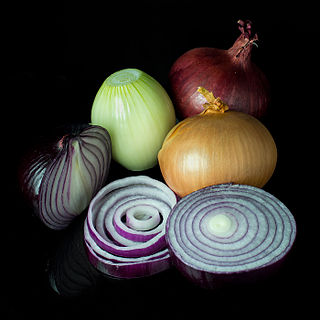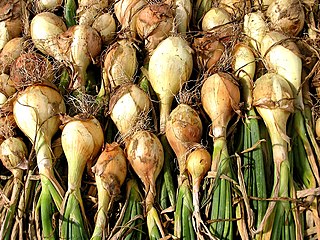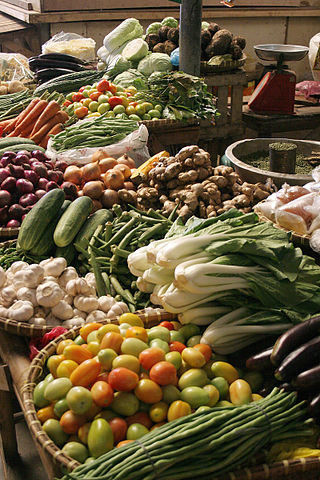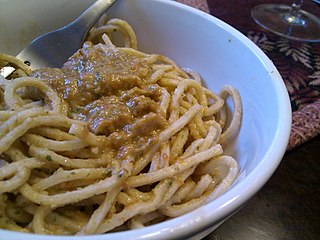
The shallot is a cultivar group of the onion. Until 2010, the shallot was classified as a separate species, Allium ascalonicum. The taxon was synonymized with Allium cepa in 2010, as the difference was too small to justify a separate species.

Garlic is a species of bulbous flowering plant in the genus Allium. Its close relatives include the onion, shallot, leek, chive, Welsh onion, and Chinese onion. It is native to South Asia, Central Asia and northeastern Iran and has long been used as a seasoning worldwide, with a history of several thousand years of human consumption and use. It was known to ancient Egyptians and has been used as both a food flavoring and a traditional medicine. China produced 73% of the world's supply of garlic in 2021.

An onion, also known as the bulb onion or common onion, is a vegetable that is the most widely cultivated species of the genus Allium. The shallot is a botanical variety of the onion which was classified as a separate species until 2011. Its close relatives include garlic, scallion, leek, and chive.

In botany, a bulb is a short underground stem with fleshy leaves or leaf bases that function as food storage organs during dormancy. In gardening, plants with other kinds of storage organ are also called ornamental bulbous plants or just bulbs.

Momordica charantia is a tropical and subtropical vine of the family Cucurbitaceae, widely grown in Asia, Africa, and the Caribbean for its edible fruit. Its many varieties differ substantially in the shape and bitterness of the fruit.

Elephant garlic is a plant belonging to the onion genus. It has a tall, solid, flowering stalk and broad, flat leaves. The flavor is milder than garlic and can be eaten raw in salads, roasted, or sauteed, but is generally not a substitute for conventional garlic in cooking. It is sometimes confused with solo garlic.

Allium vineale is a perennial, bulb-forming species of wild onion, native to Europe, northwestern Africa and the Middle East. The species was introduced in Australia and North America, where it has become an Invasive species.

The sand leek, also known as rocambole and Korean pickled-peel garlic, is a Eurasian species of wild onion with a native range extending across much of Europe, Middle East, and Korea. The species should not be confused with rocambole garlic, which is A. sativum var. ophioscorodon.

Solo garlic, also known as single clove garlic, chinese garlic, monobulb garlic, single bulb garlic, or pearl garlic, is a type of Allium sativum (garlic). The size of the single clove differs from approximately 25 to 50 mm in diameter. It has the flavour of the garlic clove but is somewhat milder and slightly perfumed. The appearance is akin to that of a pickling onion, with white skin and often purple stripes. Compared to traditional garlic, solo garlic offers the advantage of being easy to peel quickly.

Yam is the common name for some plant species in the genus Dioscorea that form edible tubers.

Garlic powder is a spice that is derived from dehydrated garlic and used in cooking for flavour enhancement. The process of making garlic powder includes drying and dehydrating the vegetable, then powdering it through machinery or home-based appliances depending on the scale of production. Garlic powder is a common component of spice mix. It is also a common component of seasoned salt.

White onion or Allium cepa are a cultivar of dry onion which have a distinct light and mild flavour profile. Much like red onions, they have a high sugar and low sulphur content, and thus have a relatively short shelf life. White onions are used in a variety of dishes, such as those of Mexican and European origin. Their uses in dishes often relate to their mild nature, they are often included in dishes to provide a light, fresh and sour taste to dishes and are often added uncooked to dishes such as salads.

Riserva naturale orientata Saline di Trapani e Paceco is an Italian nature reserve in the Province of Trapani between the municipalities of Trapani and Paceco on the west coast of Sicily. It was founded in 1995 and in the framework of the Ramsar Convention entrusted to WWF Italy. Its area of 987 hectares consists of two zones. Besides Mediterranean flora and fauna, there is a saline work museum in an old salt mill.

Vegetables are parts of plants that are consumed by humans or other animals as food. The original meaning is still commonly used and is applied to plants collectively to refer to all edible plant matter, including the flowers, fruits, stems, leaves, roots, and seeds. An alternative definition of the term is applied somewhat arbitrarily, often by culinary and cultural tradition. It may exclude foods derived from some plants that are fruits, flowers, nuts, and cereal grains, but include savoury fruits such as tomatoes and courgettes, flowers such as broccoli, and seeds such as pulses.

Paceco is a town and comune in Western Sicily, Italy, administratively part of the province of Trapani, located nearby the Trapani city area, a distance of 5 kilometres (3 mi).
Southern Exposure Seed Exchange (SESE) is a cooperatively-owned seed company based out of Mineral, Virginia. SESE is a source for heirloom seeds and other open-pollinated (non-hybrid) seeds with an emphasis on vegetables, flowers, and herbs that grow well in the Mid-Atlantic region. SESE also supports seed saving and traditional seed breeding through their product line, through lectures and workshops, and by working with over 50 small seed-growing farmers in the Mid-Atlantic and other parts of the United States. SESE publishes an intermittent email newsletter and blog for gardeners, as well as the Southern Exposure Seed Exchange Catalog and Garden Guide.

The Cipolla di Giarratana is a Sicilian variety of onion, sweet and of considerable size, with bulbs from the flattened shape which can be up to 3.5 kilograms in weight and a white-brownish tunic. It is cultivated in the comune of Giarratana, in the Hyblaean Mountains, where it is the main product of the local agriculture. A Festival, the "Sagra della cipolla", is held every August in the town.

Pesto alla trapanese is a Sicilian variation of pesto, typical of the province of Trapani. It is also known as pesto trapanese and pesto alla siciliana, and as pasta cull'agghia in the Sicilian language. It is made of garlic, basil, almonds, grated pecorino siciliano, tomatoes, salt, and black pepper, and bound with extra virgin olive oil.

Pomodorino di Manduria is an ecotype of tomato typical of Manduria, a city in the province of Taranto. In the local dialect, it is also called pummitoru paisanu.

The Red Sulmona Garlic, also known as 'Aglio rosso di Sulmona, is a Abruzzese variety of garlic; it is listed as a traditional Italian food product (P.A.T.) by the Ministry of Agricultural, Food and Forestry Policies.



















